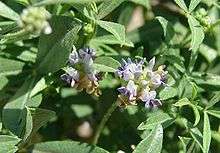Psoralidium lanceolatum
| Psoralidium lanceolatum | |
|---|---|
 | |
| Scientific classification | |
| Kingdom: | Plantae |
| (unranked): | Angiosperms |
| (unranked): | Eudicots |
| (unranked): | Rosids |
| Order: | Fabales |
| Family: | Fabaceae |
| Subfamily: | Faboideae |
| Genus: | Psoralidium |
| Species: | P. lanceolatum |
| Binomial name | |
| Psoralidium lanceolatum (Pursh) Rydb. | |
| Synonyms | |
| |
Psoralidium lanceolatum is a species of flowering plant in the legume family known by the common names lemon scurfpea and lanceleaf scurfpea. It is native to western North America from central Canada to California to Texas, where it grows in sandy habitat, in sagebrush and alluvial plains. It is a perennial herb with a branching, heavily glandular stem growing 30 to 60 centimeters tall. The leaves are palmately compound, each made up of usually three linear or lance-shaped leaflets borne on a short petiole. The inflorescence is a raceme of flowers emerging from a leaf axil. Each flower is under a centimeter long with a pealike corolla in shades of light purple-blue to white. The fruit is a hairy, glandular, spherical legume. The Zuni people eat the fresh flowers to treat stomachaches.[1]
References
- ↑ Camazine, Scott & Robert A. Bye (1980). "A study of the medical ethnobotany of the Zuni Indians of New Mexico". Journal of Ethnopharmacology. 2 (4): 365–388. doi:10.1016/S0378-8741(80)81017-8. PMID 6893476.